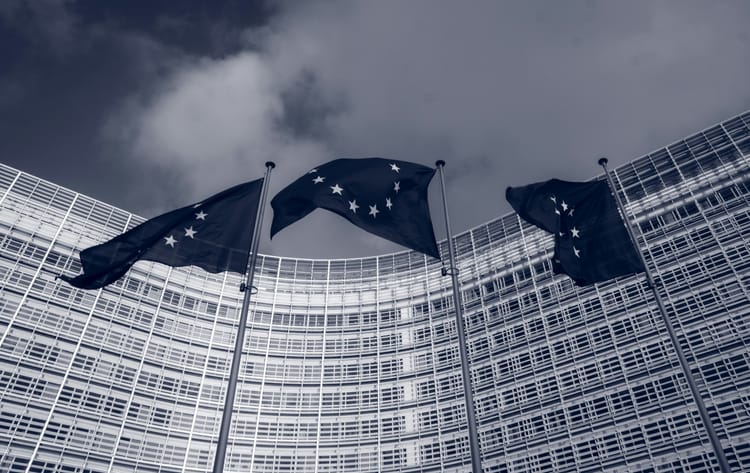CBAM! Smash! Ka-Pow! Are supply chains ready for the Carbon Border Adjustment Mechanism?

European companies will soon have to report the supply chain emissions of their non-EU imports – but reliable data from suppliers to ensure CBAM compliance may be hard to come by.
Recognised as the first international levy on carbon emissions, the Carbon Border Adjustment Mechanism (CBAM) requires European importers to pay a tax on emissions derived from carbon-intensive products manufactured outside of the EU.
The legislation was adopted by the European Commission in August 2023, and it sets high expectations for carbon data collection within value chains – a challenge given that most companies still struggle to map suppliers beyond tier one.
Developed alongside the EU’s mandatory cap-and-trade system (the Emissions Trading System or ETS), the mechanism aims to maintain the competitiveness of European manufacturers.
Heavy industry and other large energy users are having to pay an increasingly high price for carbon emissions in Europe. In August 2022, the cost of EU allowances (EUA) averaged €85 a tonne, with analysts predicting that it will exceed €100 from 2025 onwards.
For now, the imports subject to CBAM compliance are electricity, iron and steel, cement, aluminium, fertilisers and hydrogen.
These sectors were identified by the EU Commission as at high risk of “carbon leakage”, whereby manufacturers move production to other countries to avoid paying for emissions under EU law. They also make up more than 45% of the overall CO2 emissions of the sectors that fall under the ETS.
CBAM compliance: The time is now
Importers will begin to pay the CBAM tax from January 2026, at a cost aligned with that of the ETS. For products made in a jurisdiction with a local carbon tax, importers will have to pay the difference between that tax and the EUA price. This effectively extends the EU’s carbon price – one of the most expensive worldwide – to foreign manufacturers.
While there is still time before the actual tax is applied, importers are already meant to track the non-EU emissions of relevant goods since October 1, 2023 when the scheme entered its transitional phase. The first reporting period ends on January 31, 2024 for Q4 imports. From then on, EU importers will be required to submit a quarterly CBAM report disclosing the quantity of goods imported, their direct and indirect emissions and the corresponding carbon price due in the production country.
Those that do not comply with this reporting requirement will face penalties ranging from €10 to €50 for each tonne of unreported embedded emissions.
(The final text of the CBAM regulation was formally adopted by both the European Parliament and the Council in August 2023.)
Tracking supply chain emissions for CBAM compliance
This two-year transition is likely to be rocky for EU companies and their suppliers, considering the complexity of the regulation and the current state of supply chain visibility.
The exact emissions to report depend on the type of product: direct, Scope 1 emissions must be disclosed for all products, while indirect emissions from electricity use (Scope 2) and value chains (Scope 3) are required only for so-called “complex goods”.
The Commission defines “simple goods” as those requiring exclusively input materials and fuels having zero embedded emissions, and “complex goods” as those produced with the input of those simple goods. As an example within the steel industry, raw materials like limestone, iron ore or coal are not covered by CBAM; sinter, hot metal and semi-finished steel goods such as blooms, billets and slabs are considered “simple goods” (requiring Scope 1 reporting); and finished steel goods such as tubes are categorised as “complex goods”.
Within Scope 3 reporting, CBAM only covers emissions from input materials, not those associated with raw materials, transportation, consumption or end of life.
Beyond the mere complexity of understanding the requirements, it might be difficult for European importers to gather the data they need. In a report on decarbonisation in chemical supply chains by ESG consultancy Finch and Beak, Ann Dierckx, Sustainable Development Direct at chemical trade association CEFIC, noted: “Considering the complexity of many chemical products, the data collection process of carbon emissions is substantial. At the moment, Scope 1 and 2 are broadly covered (...). The data for Scope 3 are often patchy and complex to understand and report on.”
Moving away from spend-based emissions
At the moment companies can calculate emissions according to activity-based, production-based or spend-based emission factors. Activity-based emission factors are the most accurate, since they measure emissions from a specific activity. They are most used to calculate transportation emissions based on mileage, fuel type and consumption.
Production-based factors meanwhile measure emissions from particular processes, such as manufacturing.
But the most common method used to estimate emissions from complex supply chains is the spend-based model, whereby products are assigned an emissions intensity, and overall emissions are calculated based on how much the buyer spends on each product. This method requires the least amount of data, but is also the least accurate. Importers are likely to want to move towards production-based estimations to get a clearer picture of their emissions profiles under CBAM.
But this method would require more data capture and input from suppliers, and for most large companies, the simple act of mapping suppliers beyond tier one remains a challenge.
When they do, they often find disparate levels of sustainability awareness within their supply chains. As an example, Hannah Bell, Senior Procurement Sustainability Manager at Haleon, told the audience during a panel at Sustainability Live London that her company decided to fund the lifecycle analysis and carbon footprint mapping for a key supplier in India after Haleon’s carbon data request was met with a lack of understanding.
“The compliance requirements, especially the Monitoring, Reporting and Verification (MRV) system, would be the real pain for manufacturers in emerging economies. In the past few months, we have received requests from clients in Asia Pacific on how they can enhance their carbon management so that it can live up to the EU’s MRV requirements,” said Richard Lin, Partner, Carbon Management and EU Green Deal at KPMG China.
CBAM data: accuracy and interoperability
The World Business Council for Sustainable Development (WBCSB) published a first set of technical specifications last year for the exchange of carbon emissions data, as part of its Partnership for Carbon Transparency (PACT). The initiative is expected to help standardise Scope 3 accounting and improve the interoperability of various accounting systems.
“Getting everyone to provide the right data in the right format in a consistent approach is key,” Ilea Buffier, Managing Director at Australian carbon accounting software firm Evalue8 Sustainability, told CSO Futures. “Even something as simple as ‘mt’ can be interpreted as metric tonnes or megatonnes, so getting people to report the same metrics is a bigger challenge than you would imagine.” Evalue8 is currently going through PACT compliance testing to ensure its system shares transparent data in a comparable manner, and Buffier believes that will be key for the implementation of CBAM.
The EU Commission itself is “developing dedicated IT tools to help importers perform and report these calculations”, but has not given any indication of when these will be available.
Meanwhile in the private sector, some technological providers are looking to artificial intelligence to improve the accuracy of CBAM reporting.
Expect is an AI-supported carbon accounting platform aiming to help companies understand, reduce and report their supply chains’ carbon emissions. Founder and CEO Anand Verma believes generative AI can be instrumental in improving the accuracy of carbon data. He told CSO Futures: “Data is not a one-off exercise, it’s a journey. This is where generative AI could be really effective. It helps us find out very quickly if data is accurate so we can look for better inputs. We can prompt the user to look for more and more accuracy in their journey to get more data.”
Until PACT gains more ground, AI can also help reconcile data points to avoid double reporting, and “translate” data for compliance with various regulations. “AI will be very valuable in inter-geographical relationships, where standardisation is a big issue. SECR [Streamlined Energy and Carbon Reporting] in the UK is very different from CSRD [Corporate Sustainability Reporting Directive] in Europe for example, and that causes a lot of data disorganisation. Where we are coming in is to organise and classify data so that the focus is on action instead of spending months and months on Excel sheets,” he added.
While it may bring temporary headaches, CBAM has the potential to support Chief Sustainability Officers’ business case for supply chain sustainability and help them shift the focus of procurement managers from cost to carbon.
During her Sustainability Live panel, Haleon’s Bell added: “One of the next challenges in embedding sustainability is around cost, since procurement stereotypically looks at cost savings and value.” She noted that sustainability certifications tend to make products more expensive, and emphasised the need to educate procurement managers to look at sustainability from a long-term business perspective.
CBAM is expected to raise more than US$ 80 billion per year for the EU by 2040, and according to sustainability consulting firm Engie Impact, it could increase the cost of applicable commodities entering the EU by an average of 10%. This is a significant financial incentive for importers to decarbonise their supply chains.
“Any way that we can price carbon into decision making is a fantastic win, and CBAM does that well. The more we can embed it, the more that’s gonna be passed down throughout the teams across organisations,” said Buffier.







Member discussion